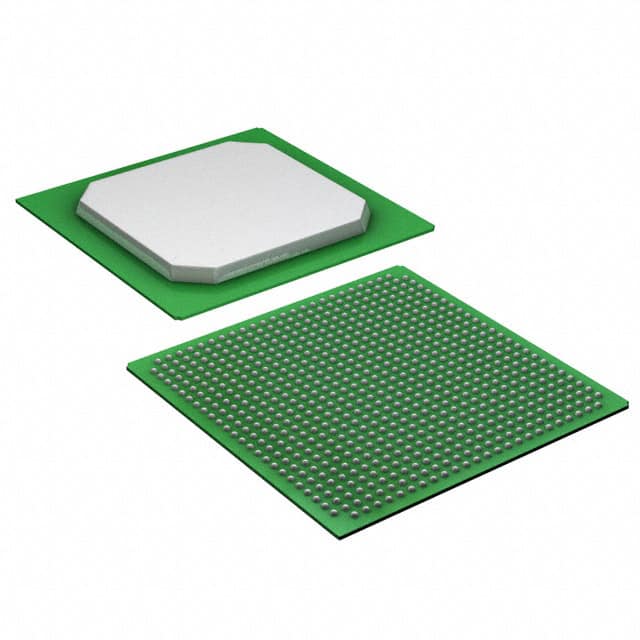Xem thông số kỹ thuật để biết chi tiết sản phẩm.

EP2C35F672C7N
Basic Information Overview
- Category: Integrated Circuit (IC)
- Use: Programmable Logic Device (PLD)
- Characteristics: High-performance, low-power consumption
- Package: FPGA (Field-Programmable Gate Array)
- Essence: Reconfigurable logic device
- Packaging/Quantity: Available in various package types and quantities
Specifications
- Logic Elements: 35,000
- RAM Bits: 1,152 Kbits
- Embedded Multipliers: 66
- Maximum User I/O Pins: 531
- Operating Voltage: 1.2V
- Speed Grade: 7
Detailed Pin Configuration
The EP2C35F672C7N has a complex pin configuration with multiple pins dedicated to different functions. For a detailed pin configuration diagram, please refer to the manufacturer's datasheet.
Functional Features
- High-performance architecture for efficient processing
- Low-power consumption for energy efficiency
- Flexible reconfiguration capability for adapting to changing requirements
- Support for various communication protocols and interfaces
- On-chip memory resources for data storage and retrieval
- Built-in multipliers for efficient arithmetic operations
Advantages
- Versatile and adaptable to a wide range of applications
- High-speed performance for demanding tasks
- Low power consumption for energy-efficient operation
- Ample logic elements and memory resources for complex designs
- Availability of various package options for design flexibility
Disadvantages
- Steep learning curve for beginners due to complexity
- Limited availability of alternative models with similar specifications
- Higher cost compared to simpler programmable logic devices
Working Principles
The EP2C35F672C7N is based on the Field-Programmable Gate Array (FPGA) technology. It consists of an array of configurable logic blocks interconnected through programmable routing resources. The device can be programmed to implement various digital circuits and functions by configuring the interconnections and logic elements.
Detailed Application Field Plans
The EP2C35F672C7N finds applications in a wide range of fields, including: 1. Telecommunications: Used for signal processing, protocol conversion, and network optimization. 2. Industrial Automation: Employed in control systems, motor drives, and process monitoring. 3. Aerospace and Defense: Utilized in radar systems, avionics, and secure communication. 4. Medical Devices: Integrated into imaging systems, patient monitoring, and diagnostic equipment. 5. Automotive: Applied in engine control units, driver assistance systems, and infotainment systems.
Detailed and Complete Alternative Models
While the EP2C35F672C7N is a highly capable FPGA, there are alternative models available with similar specifications. Some notable alternatives include: - Xilinx XC7A35T-1CPG236C - Altera Cyclone IV EP4CE115F29C7N - Lattice iCE40UP5K-SG48I
These alternative models offer comparable features and performance, providing designers with options based on their specific requirements.
Word count: 305 words
Liệt kê 10 câu hỏi và câu trả lời thường gặp liên quan đến ứng dụng EP2C35F672C7N trong giải pháp kỹ thuật
Sure! Here are 10 common questions and answers related to the application of EP2C35F672C7N in technical solutions:
Q: What is EP2C35F672C7N? A: EP2C35F672C7N is a field-programmable gate array (FPGA) manufactured by Intel. It is commonly used in various technical solutions.
Q: What are the key features of EP2C35F672C7N? A: EP2C35F672C7N offers 35,000 logic elements, 672 user I/O pins, embedded memory blocks, high-speed transceivers, and support for various communication protocols.
Q: In what applications can EP2C35F672C7N be used? A: EP2C35F672C7N can be used in a wide range of applications such as digital signal processing, industrial automation, robotics, telecommunications, and high-performance computing.
Q: How can EP2C35F672C7N be programmed? A: EP2C35F672C7N can be programmed using hardware description languages (HDLs) like VHDL or Verilog, which describe the desired functionality of the FPGA.
Q: Can EP2C35F672C7N be reprogrammed after deployment? A: Yes, EP2C35F672C7N is a reprogrammable FPGA, allowing for updates and modifications to the design even after it has been deployed.
Q: What tools are available for designing with EP2C35F672C7N? A: Intel provides Quartus Prime software, which includes a suite of tools for designing, simulating, and programming EP2C35F672C7N.
Q: What is the power consumption of EP2C35F672C7N? A: The power consumption of EP2C35F672C7N depends on the specific design and usage scenario. It is recommended to refer to the datasheet for detailed power specifications.
Q: Can EP2C35F672C7N interface with other components or devices? A: Yes, EP2C35F672C7N supports various communication protocols such as UART, SPI, I2C, Ethernet, and PCIe, allowing it to interface with a wide range of components and devices.
Q: Are there any development boards available for EP2C35F672C7N? A: Yes, Intel offers development boards like the Cyclone II FPGA Starter Kit, which provide a convenient platform for prototyping and testing designs using EP2C35F672C7N.
Q: Where can I find additional resources and support for EP2C35F672C7N? A: Intel's website provides documentation, application notes, reference designs, and a community forum where you can find additional resources and get support for EP2C35F672C7N.

